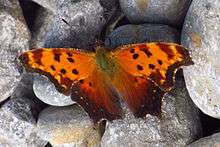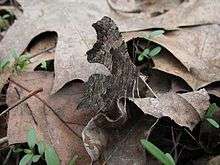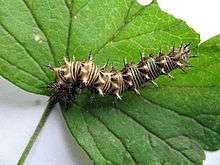Polygonia progne
Polygonia progne, the gray comma or grey comma, is a species of Polygonia that occurs in North America.
| Polygonia progne | |
|---|---|
 | |
 | |
| Scientific classification | |
| Kingdom: | Animalia |
| Phylum: | Arthropoda |
| Class: | Insecta |
| Order: | Lepidoptera |
| Family: | Nymphalidae |
| Genus: | Polygonia |
| Species: | P. progne |
| Binomial name | |
| Polygonia progne (Cramer, 1775) | |
| Subspecies | |
| |
| Synonyms | |
Description

Its wingspan is between 4.4 and 6.3 cm. The top of the wings is bright orange brown while the summer forms often have a dark border on the hindwing. Both winter and summer forms have few yellow spots on their wing borders. The underside of the wings have L-shaped silver markings and are charcoal gray.
Habitat
They can often be found around dirt roads and stream beds. Most often they are found in hilly terrain or canyon lands.
Life cycle
The adults are on wing two times a year, once in April and May and another in June and August. During the first flight the adults mate and lay eggs. These eggs will hatch and become the summer generation. The summer generation's eggs will hatch in October and hibernate.
Larval foods
Adult foods
- Plant sap
- Rarely flower nectar
References
- Markku Savela. "Nymphalis progne (Cramer, [1775])". Lepidoptera and Some Other Life Forms. Retrieved 2008-11-18.
- "Species Polygonia progne - Gray Comma". Retrieved 2008-11-18.
External links
| Wikimedia Commons has media related to Polygonia progne. |
- Grey comma, Butterflies of Canada